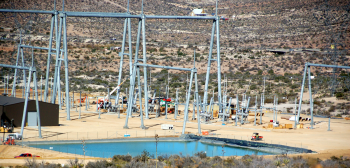
By Miriam Raftery
February 18, 2017 (San Diego’s East County) – San Diego Supervisors have rejected plans for a renewable energy overlay zone feasibility study, which would have cost an estimated half million dollars. The action came during a hearing on a Comprehensive Renewable Energy Plan.
Donna Tisdale, Chair of the Boulevard Planning Group and founder of Backcountry Against Dumps (BAD), voiced relief at the Supervisors’ rejection of the overlay zone. “A renewable energy overlay zone would fast track any projects located within the designated boundaries. Based on some previous information, we had concerns that a renewable energy overlay zone would be placed over the Boulevard Planning Area and/or the Jacumba Planning Area,” she told ECM.
Speaking in favor of the overlay zone was Jim Whalen, lobbyist for SDG&E, Sempra, Tule Wind, Soitec, Hamann Companies and other energy interests. The zone would be backed by a new state law authorizing Infrastructure Finance Districts that help finance infrastructure projects such as wind, solar and electrical infrastructure.
Supervisor Dianne Jacob spoke out in opposition, saying such a zone was unnecessary. No other supervisors supported it.
The overlay zone may be included in the pending Draft EIR for the Climate Action Plan, but Board support for it seems unlikely at this point, Tisdale told ECM, adding, “We must enjoy our victories regardless of how brief they may be.”
In her testimony to Supervisors, Tisdale argued that the Boulevard Planning Area, which is predominantly low income, relies 100% on groundwater and has a high fire danger, has already been disproportionately impacted by a barrage of industrial-scale energy projects and transmission lines.
Attorney Stephan Volker, in a letter to Supervisors on behalf of Tisdale and BAD, observed, “Incredibly, in comparing the costs and benefits of the overlay zone, the Report and Executive Summary do not even consider the unequal environmental, social and health impacts that the backcountry has already suffered from this electrical industrialization, and which an overlay zone would exacerbate. The sole listed “Disadvantages” are “Staff time and Resources” and “High Start-Up Costs” (Executive Summary, p. 34). That claim is demonstrably false. The adverse impacts to wildlife, scenery, groundwater, wildfire risk and human health and safety are both significant and well-documented.”
Supervisors, at the same meeting, also rejected a $200,000 feasibility study on a community choice energy aggregate, (CCA) as an alternative power source to SDG&E, a $200,000 feasibility study on micro grids, and the$500,000 study on renewable energy overlay zones, deeming all of the studies unnecessary at this time. Some justified these decision based on the potential for these items to come up again in the draft environmental impact report for the new Climate Action Plan that is expected out for public comment in the next few months.
The San Diego Union-Tribune reports that SDG&E's parent company, Sempra Energy, has admitted to meetings with Supervisors on the CCA despite concerns raised by the California Public Utilities Commission about the legality of any such lobbying by the utility. The utility has applied to set up a marketing arm but according to the CPUC, approval for any lobbying efforts remains pending.
“We’re very concerned that they are basically defying the state,” said Nicole Capretz, executive director of Climate Action Campaign, which has advocated strongly for CCAs throughout the county. “I don’t know what’s going on. As of today, they don’t have authority to operate.”








Comments
Financing
Is a Infrastructure Finance District another name for increased property taxes to pay for the Project?
I think it is.
A neighbor complained there weren't street lights on my street, Lights were installed and a fee appeared on my tax form.